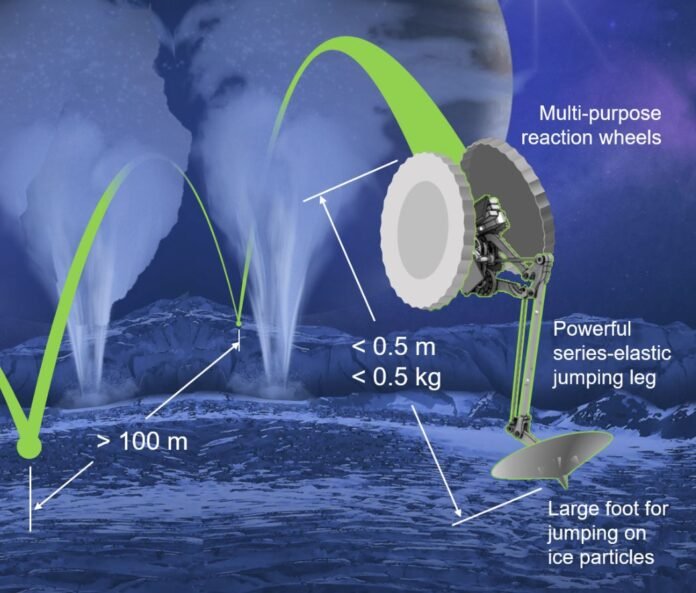Locomotion makes things move, and certain forms of locomotion make them move better than others. Those more effective types of locomotion change depending on the environment, which is even more true for space exploration. Methods that might work well on Earth or even other planets, such as helicopters, might be utterly useless on others. But, specialized forms of locomotion abound, and the NASA Institute of Advanced Concepts (NIAC) phase I grants for this year include a closer look at one such specialized form – jumping.
The Legged Exploration Across the Plume (LEAP) program would utilize a specially designed jumping robot to explore the lower parts of the massive plumes emitted from Enceladus. The concept is based on the Salto jumping robot, initially developed by a team at UC Berkeley. Justin Yim, now a professor at the University of Illinois and the NIAC Phase I grantee, worked on it as part of his PhD thesis.
In an interview with Fraser, Dr. Yim details what makes Salto unique. For its size, which measures only about 50 centimeters, and weight, which is planned for less than .5 kg, Dr. Yim believes the robot could jump upwards of 100m horizontally on the surface of Enceladus.

Credit – Justin Yim / NASA
That is a significant advantage over other forms of locomotion on the icy moon. Enceladus has no atmosphere, so flying would have to be powered by a rocket, which will use up fuel, rather than by rotors, like Ingenuity was able to do on Mars. However, the surface is also icy and uneven, making having a rover trundle impractical.
Jumping, however, offers the best of both worlds. It requires relatively little power and, as such, could be done multiple times without depleting a robot’s battery. But it is also terrain agnostic, soaring above the most challenging parts. It would also allow the robot to jump directly through the lower part of the plumes that Enceladus ejects into the Saturnian system, the remnants of which form one of Saturn’s spectacular rings.
No other form of locomotion would be able to get that close to the source of the plumes, and since those plumes are some of the most interesting parts of Enceladus, studying them up close is appealing for many reasons. One mission in particular, the Enceladus Orbilander, which was a proposed flagship mission that the 2023 Decadal Survey supported, would be able to capture the upper parts of a geyser as it flew through one on its orbital path but would be unable to collect any data on its lower parts. At least as initially envisioned, its lander wouldn’t be capable of moving through a geyser.
Credit – CNET YouTube Channel
LEAP could potentially hitch a ride with the system, though. Utilizing the lander as a launch platform would save significant design effort of the robot itself. It could even use the Orbilander as a recharging station, allowing it to explore even further afield.
There are some challenges, though – the original design of Salto only had one reaction wheel, which allowed its engineers to control the robot pitch, allowing it to perform the feet of aligning for multiple jumps off walls, kind of like characters do in video games. However, to truly control itself, LEAP would need two other reaction wheels to control yaw and rolls, giving engineers direct control over all three axes of the robot’s orientation. Dr. Yim added that, as part of the Phase I study, the researchers planned to assess using those reaction wheels to control motion in these three dimensions to assist in righting the robot if it falls over. Inevitably, given Enceladus’s rough and icy slick surface, it will undeniably eventually fall over.
As Dr. Yim discusses with Fraser, there is always a trade-off between size, weight, and capability for robots. Even larger versions of LEAP wouldn’t necessarily be able to travel as far or as efficiently as a smaller one does – though they might be able to carry more payload. One of the limitations of a small jumping robot is the mass limits placed on its ability to jump. Therefore, Dr. Yim expects simple instrumentation, like a flow meter and a camera, to be the extent of what LEAP will be able to carry into the plume, rather than fancier instrumentation like a mass spectrometer that might provide more insight but would be too bulky for jumping.
Credit – BiomimeticMillisys YouTube Channel
Like all NIAC Phase I projects, this one is still very early in development. The outcome of this round is expected to be a case study that shows the parameters that must be considered in any future design or prototyping. Whether or not it ends up on Enceladus, the jumping concept behind LEAP appears to be an important locomotion style for many future robots, so expect to see more jumping around near you sometime soon.
Learn More:
NASA / Justin Yim – LEAP – Legged Exploration Across the Plume
UT – A Hopping Robot Could Explore Europa Using Locally Harvested Water
UT – A Robot Hopper to Explore the Moon’s Dangerous Terrain
UT – Miniaturized Jumping Robots Could Study An Asteroid’s Gravity
Lead Image:
Artist’s depiction of the LEAP robot jumping over a geyser on Enceladus.
Credit – NASA / Justin Yim


